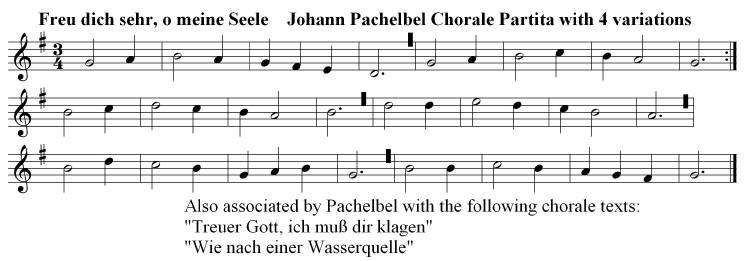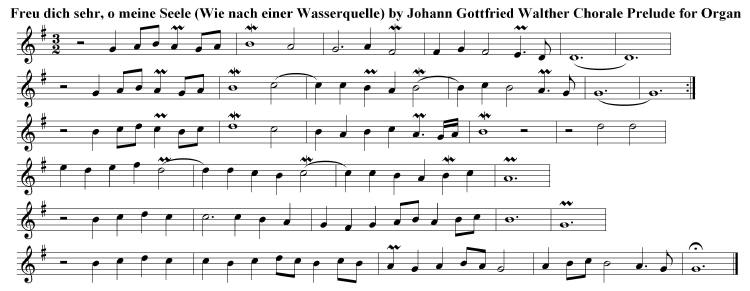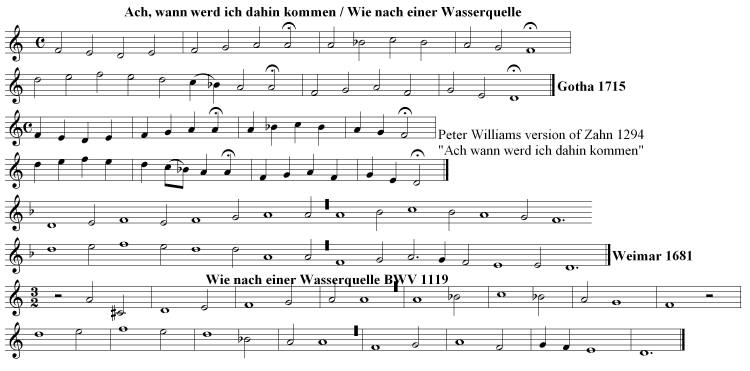|
Chorale Melodies used in Bach's Vocal Works
Freu dich sehr, o meine Seele |
|
Melody & Text | Use of the CM by Bach | Use of the CM by other composers
| Arragements/Transcriptions
Alternate, but not clearly related melody | Use of Alternate Melody by Bach |
| |
|
Melody & Text: |
|
Composition: Zahn: Zahn 6543 | EKG: 319 |
|
Louis Bourgeois, in creating his chorale/Psalm melody for the Geneva Psalm 42 “Ainsi que la biche rée” in his collection of Psalms in “Pseaumes octante trios de David” [Geneva, 1551] took a secular song “Ne l’oseray je dire” contained in “Manuscrit de Bayeux” (circa 1510) and transformed it into a sacred chorale/Psalm melody.
An Early German Source: Johann Jeep has a 4-pt setting from which this early shape of the melody can be determined: |
|

|
|
As will be clearly seen in Bach’s use of the melody, it can be found used in both duple and triple rhythm. |
|
Dick Wursten added (November 22, 2011):
Freu dich sehr = melody of ps. 42 in the Geneva Psalter
Composer of this melody = Louis (or Loys) Bourgeois.
First appeared in Geneva, Psaumes Octantetrois de David (83 Psalms of David) 1551.
[whether this melody is really based on a chanson, as you say – quoting Frank Dobbins, I doubt: the myth that the geneva Psalmtunes are based on chansons seems to be ineradicable] |
| |
|
Text : Freu dich sehr, o meine Seele |
|
The first appearance of the text is anonymous and can be traced back to Freiberg, Saxony (1620). |
| |
|
Alternate Texts: |
|
Use of Melody with Alternate Texts by Other Poets:
Text 2: Johann Heermann: Zion klagt mit Angst und Schmerzen (1636)
Text 3: Johann Heermann: Treuer Gott, ich muß dir klagen (1630)
Text 4: David Denicke: Kommt, laßt euch den Herren lehren (1648)
Text 5: Johann Olearius: Tröstet, tröstet meine Lieben (1671)
Text 6: Paul Gerhardt: Weg, mein Herz, mit den Gedanken (1647) |
| |
|
Use of the Chorale Melody by Bach: |
|
Text : Freu dich sehr, o meine Seele
Author: Anon (1620) |
|
Ver |
Work |
Mvt. |
Year |
Br |
RE |
KE |
Di |
BC |
Score |
Music Examples |
|
9 |
BWV 19 |
Mvt. 7 |
1726 |
297 |
99 |
298 |
87 |
A180:7 |
PDF | PDF ch |
Mvt. 7 (MG) | Mvt. 7 (MG) ch [midi] | Mvt. 7 (Leusink) [ram] |
|
10 |
BWV 70 |
Mvt. 7 |
1723 |
- |
98 |
- |
|
A165:7 |
PDF |
Mvt. 7 (MG) [midi] | Mvt. 7 (Leusink) [ram] |
|

|
|

|
| |
|
Text 2: Zion klagt mit Angst und Schmerzen
Author: Johann Heermann (1636) |
|
Ver |
Work |
Mvt. |
Year |
Br |
RE |
KE |
Di |
BC |
Score |
Music Examples |
|
2 |
BWV 13 |
Mvt. 3 |
1726 |
- |
- |
- |
|
A34:3 |
|
Mvt. 3 (Leusink) [ram] |
|

|
| |
|
Text 3: Treuer Gott, ich muß dir klagen
Author: Johann Heermann (1630) |
|
Ver |
Work |
Mvt. |
Year |
Br |
RE |
KE |
Di |
BC |
Score |
Music Examples |
|
12 |
BWV 25 |
Mvt. 6 |
1723 |
254, 282 |
101 |
282 |
11 |
A129:6 |
PDF | PDF v1 | PDF v2 |
Mvt. 6 (MG) | Mvt. 6 (MG) ver 1 | Mvt. 6 (MG) ver 2 [midi] | Mvt. 6 (Leusink) [ram] |
|
6 & 7 |
BWV 194 |
Mvt. 6 |
1723 |
63, 256 |
100 |
64, 256 |
18 |
A91:6 |
PDF | PDF v |
Mvt. 6 (MG) | Mvt. 6 (MG) ver [midi] | Mvt. 6 (Leusink) [ram] |
|

|
|

|
| |
|
Text 4: Kommt, laßt euch den Herren lehren
Author: David Denicke (1648): |
|
Ver |
Work |
Mvt. |
Year |
Br |
RE |
KE |
Di |
BC |
Score |
Music Examples |
|
6 |
BWV 39 |
Mvt. 7 |
1726 |
67 |
104 |
67 |
116 |
A96:7 |
PDF | PDF v |
Mvt. 7 (MG) | Mvt. 7 (MG) ver [midi] | Mvt. 7 (Leusink) [ram] |
|

|
| |
|
Text 5: Tröstet, tröstet meine Lieben
Author: Johann Olearius (1671) |
|
Ver |
Work |
Mvt. |
Year |
Br |
RE |
KE |
Di |
BC |
Score |
Music Examples |
|
3 |
BWV 30 |
Mvt. 6 |
1738 |
76 |
103 |
76 |
- |
A178:6 |
PDF | PDF v |
Mvt. 6 (MG) | Mvt. 6 (MG) ver [midi] | Mvt. 6 (Leusink) [ram] |
|

|
| |
|
Text 6: Weg, mein Herz, mit den Gedanken
Author: Paul Gerhardt (1647) |
|
Ver |
Work |
Mvt. |
Year |
Br |
RE |
KE |
Di |
BC |
Score |
Music Examples |
|
12 |
BWV 32 |
Mvt. 6 |
1726 |
29 |
102 |
29 |
- |
A31:6 |
PDF |
Mvt. 6 (MG) [midi] | Mvt. 6 (Leusink) [ram] |
|

|
| |
|
Use of the Chorale Melody by other composers: |
|
The main melody: |
|
Johann Jeep (1582-1644):
Freu dich sehr, o meine Seele, 4-pt setting for voices., appeared posthumously in L. Erhard(i)'s Harmonisches Chor- vnd Figural Gesangbuch (Frankfurt am Main, 1659). See: Score |
|
Anthoni van Noordt (1619-1675):
Freu dich sehr, o meine Seele for organ |
|
Johann Pachelbel (1653-1706):
Chorale Variations on Freu dich sehr, o meine Seele (Treuer Gott, ich muss dir klagen) (4 variations), T. 87. |
|

|
|
Georg Böhm (1661-1733):
Freu dich sehr, o meine Seele, for pedal clavier (?) Chorale Partita |
|
Georg Friedrich Kauffmann (1679-1735):
Freu dich sehr, o meine Seele Chorale Prelude for Organ (Leipzig, 1733). |
|

|
|
Georg Philipp Telemann (1681-1767):
Freu dich sehr, o meine Seele, Cantata for 4 (or more) voices, flute, 2 oboes, strings, and bc, TWV 1:555 (1721) |
|
Johann Gottfried Walther (1684-1748):
Freu dich sehr, o meine Seele Chorale Prelude for Organ. |
|

|
|
Gottfried Kirchhoff (1685-1746):
Freu dich sehr, o meine Seele, Chorale Prelude for Organ |
|
Christian Michael Wolff (1707-1789):
Andantino and chorale, Freu dich sehr, o meine Seele in Sammlung kleiner Clavier- und Singstücke (Leipzig, 1774) |
|
Johann Ludwig Krebs (1713-1780):
Freu dich sehr, o meine Seele, Chorale Prelude for Organ |
|
Johann Christian Rinck (1770-1846):
Chorale and 7 Variations on Freu dich sehr, o meine Seele for organ |
|
Albert Steinicke (1st half of 19th century):
"Freu dich sehr, o meine Seele", choral for organ |
|
Max Reger (1873-1916):
Phantasie über den Choral Freu' dich sehr, o meine Seele, Op. 30 (1898)
Freu dich sehr, o meine Seele, Chorale Prelude for Organ, Op. 67/11 (1902)
Freu dich sehr, o meine Seele, Chorale Prelude for Organ, Op. 135a/9 (1914) |
|
Sigfrid Karg-Elert (1877-1933):
Freu dich sehr, o meine Seele, chorale improvisation for organ (Sarabande), Op. 65/5 |
|
Anton Heiller (1923-1979):
Freu dich sehr, o meine Seele, Chorale Partita for Organ (1949) |
|
Marcel Dupré (1886-1971):
Chorale for organ Freu dich sehr, O meine Seele, Op. 59/1 (1963) |
|
J.S. Bach (Doubtful):
Freu dich sehr, o meine Seele, Chorale Prelude for Organ, BWV Anh. 52
Freu dich sehr, o meine Seele, Chorale Prelude for Organ, BWV Anh. 53
The entire sequence of numbers in the group BWV Anh II 47-72 were listed by the BWV as of doubtful authenticity, and the NBA has not even included them in their complete edition of Bach's works. There is almost no possibility that these organ works will ever be identified as being by J. S. Bach. |
| |
|
Arrangements/Transcriptions of Bach's use of the Chorale Melody: |
|
See list of Piano Transcriptions of BWV 39/7 by various composers/arrangers at:
Piano Transcriptions of Bach's Works - Index by BWV Number Part 1: Cantatas |
| |
|
Alternate, but not clearly related melody : Zahn: 1294 |
|

|
|
This melody is listed under various titles: “Wie nach einer Wasserquelle” or “Ach, wann werd ich dahin kommen” or “Ach, was ist doch unser Leben” or “Treuer Gott, ich muß dir klagen” and even “Freu dich sehr, o meine Seele”
Similar to the latter melody described above, this melody can also be traced back to Louis Bourgeois in another one of his French Psalm melodies “Comme un cerf altéré brame” But this melody differs from the main melody for “Freu dich sehr, o meine Seele” in a number of different, but very important respects.
Since the meters of both Zahn 1294 and Zahn 6543 are very different, this has presented an insurmountable problem and considerable confusion to musicologists with some even unwittingly repeating mistaken connections, like Peter Williams (in his revised “The Organ Music of J. S. Bach” [Cambridge University Press, 2003, p. 573]) who must have based his statement about the connection between the two melodies upon the extremely misleading equation given by the BWV:
“Freu dich sehr, o meine Seele” = “Wie nach einer Wasserquelle”
Having made these chorale melody titles equivalent, the BWV Verzeichnis unashamedly lists, by using indentation to indicate their dependency upon and subordination to the main title (“Wie nach einer Wasserquelle”), the following cantata mvts.: BWV 13/3; BWV 19/7; BWV 25/6, BWV 30/6; BWV 32/6; BWV 39/7; BWV 70/7; BWV 194/6, but not one of these (all of them Zahn 6543) fits Bach’s use of “Wie nach einer Wasserquelle” in BWV 1119 (one of the Neumeister chorale preludes for organ), leading Mark Bighley (“The Lutheran Chorales in the Organ Works of J. S. Bach” [St. Louis, MO, 1986] to speculate that Bach must have used a corrupted version of the melody that was in one of the hymnals that he used. The NBA KB IV/9 (2003, p. 53) editors, however, believe that it is more likely that Bach himself was confused by the variants of the melody (Zahn 1294) and (Zahn VI, p. 576) as contained in the Gotha Hymnal, 1715, No. 325, p. 198ff. This, however, does not explain the much greater confusion of Zahn 6543 and Zahn 1294 where meters and melody lines have many differences: Zahn 6543 : 87 87 7788 Zahn 1294 : 8787. The beginnings of each melody are quite different as the score samples below will demonstrate. Although there are a few similarities, the differences between these melodies are considerable and make it impossible for Peter Williams to maintain that “The MELODY’s origin is not known and perhaps had no single or fixed form; one or other version was used by six further texts in eight Leipzig cantatas.” [He can only be referring to the Bach Verzeichnis list given earlier in this paragraph.]
|
|
Texts for Alternate Melody: |
|
The chorale (text and melody association) for “Ach wann werd ich dahin kommen” makes its earliest appearance in the Weimar Hymnal of 1681 where it has 9 verses with 4 lines each. Beginning with the 2nd verse, it paraphrases Psalm 42 (“Wie der Hirsch schreiet nach frischem Wasser….” The 1st line of the 2nd verse begins with “Wie nach einer Wasserquelle” Both of the chorales by Ambrosius Lobwasser and David von Schweinitz that begin with the same first line “Wie nach einer Wasserquelle” have verses with 8 lines each (87 87 77 88.) It is impossible to sing these texts to the melody designated as Zahn 1294 which has only 4 lines with the meter 87 87; hence they were usually sung to the melody of “Freu dich sehr, o meine Seele” (Zahn 6543) which is the same as in the Weimar Tabulaturbuch of 1704.
Lobwasser’s 1st verse is as follows:
Wie nach einer Wasserquelle
ein Hirsch schreiet nach Begier,
also auch mein arme Seele
ruft und schreit, Herr Gott, zu dir;
nach dir, lebendiger Gott,
sie Durst und Verlangen hat.
Ach, wann soll es dann geschehen,
daß ich dein Antlitz mag sehen.
A chorale text that was sung to Zahn 1294 is one by Johann Christoph Kohlhans (1666) entitled: “Ach, wann werd ich dahin kommen” Score
Its lines easily fit the chorale melody which Bach uses in BWV 1119 with the title “Wie nach einer Wasserquelle.” Here are the first two verses of the Kohlhans chorale text which does fit:
1. Ach, wann werd ich dahin kommen,
daß ich Gottes Angesicht
schau, und was er denen Frommen
in dem Himmel zugericht’.
2. Wie nach einem Wasserbrunnen
ein Hirsch schreiet mit Begier,
also auch mit meiner Zungen
lechz ich, o Herr Gott zu dir.
Lobwasser’s earlier version has the first 4 lines corresponding to Kohlhans’s 2 verse metrically. The last 2 lines of Lobwasser’s verse correspond to the first two lines of Kohlhans’s 1st verse. The correspondences are present and the possibility of confusion or mistaking one for the other is great indeed. Just how this led to the naming of the chorale melody (Zahn 1294) as “Wie nach einer Wasserquelle” is not clear. Perhaps the Kohlhans chorale text was often sung without the 1st verse. Bach repeated this confusion in regard to a work which he left unfinished except for the title: “Wie nach einer Wasserquelle.” In Bach’s Weimar Orgelbüchlein for Chorale No. 121, he uses this title and leaves only sufficient space for the composition of a 4-line chorale. It is clear that he is referring to Zahn 1294 which should be known as “Ach wann werd ich dahin kommen.” (all of this information given on pp. 52-53 of NBA KB IV/9)
From the Grove Music Online {Oxford University Press, 2005, acc. 9/10/05), here is a pertinent comment by Robert L Marshall and Robin A. Leaver on Lobwasser’s contribution to the German chorale tradition: |
|
>> On the other hand, the verse-for-verse translation of the Genevan Psalter by the Lutheran Ambrosius Lobwasser ( Leipzig, 1573) brought Calvinist melodies into the German tradition at a relatively early date. These were later transferred to other psalm or chorale texts, the best-known being “Freu dich sehr, o meine Seele” to the melody of Psalm xlii and Paul Eber’s “Herr Gott, dich loben alle wir” to the melody of Psalm cxxxiv.<<
|
|
and also from Grove Music Online by Howard Slenk and Janr. Luth: |
|
>>A translation of the Marot-Bèze psalms became by far the best-known psalter in Germany. In 1565 Ambrosius Lobwasser finished his translation of the entire French psalter into German. It was published in Leipzig in 1573, and entitled “Der Psalter dess königlichen Propheten Davids, in deutsche reyme verstendiglich und deutlich gebracht.” The Lobwasser translation enjoyed immediate popularity, and was used by Lutheran congregations as well as Calvinist. As a result, several Calvinist melodies found a permanent place in the Lutheran repertory (e.g. Psalm xlii = ‘Freu dich sehr, o meine Seele’; ‘Les commandemens de Dieu’ = ‘Wenn wir in höchsten Nöten sein.’ One of the reasons for the popularity of Lobwasser’s work was that his texts were usually accompanied in print by the homophonic settings of Goudimel. (Part-singing of the psalms was introduced into the German Calvinist service long before it was permitted in Geneva or the Low Countries.)<<
|
|
A final observation: The BWV Verzeichnis lists “Ach, wann werd ich dahin kommen” as Zahn 6543 but gives no BWV number examples. In any case, this combination is a sheer impossibility in light of the discussion above the CM score samples given here. |
| |
|
Use of Alternate Melody (Zahn 1294) by Bach: |
|
Untexted: |
|
Ver |
Work |
Mvt. |
Year |
Br |
RE |
KE |
Di |
BC |
Score |
Music Examples |
|
* |
1119 |
- |
b 1710 |
- |
- |
- |
- |
K193 |
- |
|
|
** |
743 |
- |
? |
- |
- |
- |
- |
K121 |
- |
|
|
* Chorale Prelude from the Neumeister Collection.
**Doubtful authenticity – not accepted by NBA Title: “Ach, was ist doch unser Leben" |
|

|
| |
|
Sources: NBA, vols. III/2.1 & 2.2 in particular [Bärenreiter, 1954 to present] and the BWV ("Bach Werke Verzeichnis") [Breitkopf & Härtel, 1998]
The PDF files of the Chorales were contributed by Margaret Greentree J.S. Bach Chorales
Software: Capella 2004 Software, version 5.1.
Prepared by Thomas Braatz & Aryeh Oron (September
2005 - November 2011) |